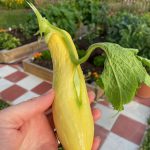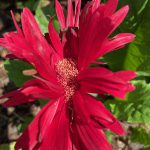You never know what surprises are looming in your flower gardens.
This Rudbeckia in the photo to the left sported one bloom that was so different from all the others. The disk or central portion of the inflorescence was elongated and curved back on itself and created a contorted, crazy looking bloom. And then there was a yellow squash in my garden that had a leaf growing down the length of the squash. What caused these things to happen?
This is a mutation, often genetic, but also could be caused by outside influences such as pathogens, injuries, or chemicals. Plant hormones may also play a role in this phenomenon. This mutation expresses itself as a malformation or cresting at the tip or growing point of the plant, also known as the meristem. We call this fasciation and it begins when the cells at a growing point of a plant start dividing in an uneven or asymmetrical fashion instead of the normal symmetrical pattern.
There are some plants we embrace for their fasciation. A common one is cockscomb celosia that is prized for its showy crested inflorescence. Cacti and succulents more commonly exhibit fasciation and we can see it in some of the crested cacti.
Take a close look at what is happening in your garden and landscape. Plant biology is fascinating!
- Sugar Belle Mandarin: A Great Choice for the Florida Panhandle - November 22, 2021
- LandscapeQ & A - August 20, 2021
- Let’s Talk Beneficial Insects - August 18, 2021




